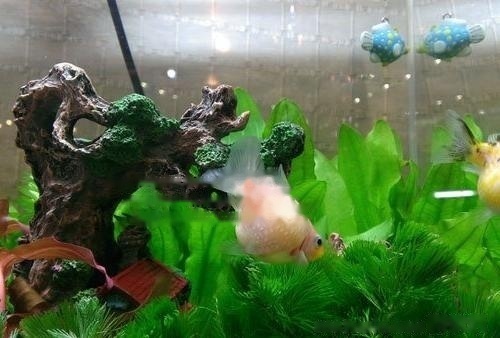Algae growth is an inevitable problem in almost all aquatic fish tanks. If a beautiful aquarium has thick algae or moss, the beauty will be greatly reduced. However, we can still try to suppress the growth of algae by understanding the reasons for the occurrence of algae, so as to avoid hindering players from enjoying the beauty of the aquatic plant tank.

The types of algae are: common diatoms, speckled green algae parasitic on the surface of aquatic plants or attached to glass, filamentous algae, and the most troublesome of cyanobacteria and algae, etc. Next, I will introduce the causes of algae growth and preventive measures~
1. Light quantity and lighting time
Aquatic plants Both light and carbon dioxide are necessary for photosynthesis, so light is also a big factor in promoting algae reproduction. That is, don't expose the tank to strong light for long periods of time. Avoid placing fish tanks in direct sunlight. BUT! If the light is too weak, the aquatic plants will not be able to fully perform photosynthesis, which will make the aquatic plants in poor condition, and make the algae easy to parasitize! Therefore, we can know that the light intensity and the length of the lighting time are very important. If you use fluorescent lamps, the recommended best lighting time is about 7 to 9 hours; in addition, water plants have a certain period of time for photosynthesis, so it is best to fix the lighting time every day~
2. Insufficient carbon dioxide
Insufficient carbon dioxide in the fish tank will make the aquatic plants unable to perform photosynthesis smoothly and become weak, and the algae will be easy to parasitize. Excessive reproduction of algae will increase the PH value of the water, destroy the water quality environment, and affect the growth of aquatic plants. It can be said to be a vicious circle. Therefore, to inhibit the growth of algae, you can also start from maintaining the content of carbon dioxide in the water and the hardness of the water.
3. Nutrients
The nutrients in the fish tank come from fertilizers, feed residues, fish excrement, etc. Not only do aquatic plants use these nutrients to help grow, but algae also benefit. The best fish tank environment is to allow water plants to absorb nutrients and inhibit the growth of algae. Therefore, too little water plants or too many nutrients are not ideal!
4. Dissolving in water Oxygen
High dissolved oxygen in water will activate algae. When the light is turned on, the oxygen content will be saturated due to the photosynthesis of the aquatic plants. Once the dissolved oxygen in the water is saturated, bubbles will appear on the aquatic plants. In addition, if the player uses an aerator for aeration, it is best not to do it when the lights are turned off. Basically, when there is no light at night, carbon dioxide will escape a little, and pumping will accelerate the release of carbon dioxide, causing the pH value to rise, but the dissolved oxygen will continue to maintain a near-saturated state, and it will become an environment suitable for algae growth. !
The means of human beings
The water quality is unstable at the initial stage of setting up the tank, and it is also the time when algae are easy to multiply. Players can change the water according to the changes in water quality. It's just that changing all the water is a big project, and it will change the water quality. Therefore, it is recommended to change 1/3 to 1/4 of the water at a time. Depending on the water quality, change it about 2 to 3 times a week. When the water quality is stable, the aquatic plants will be healthy, and it will not be easy to be parasitized by algae. But don't take it for granted that algae will be completely eliminated! Sometimes there is still some algae on the glass of the fish tank, and that little bit of algae can be brushed off with a brush when cleaning, don't worry about it.
If algae are found on the aquatic plants, it is best to cut off the whole piece. As for the algae attached to the wood or stone, you can spray it with an algaecide (wood vinegar solution) to make it fragile, and then let the Yamato algae shrimp eat it clean. In addition, if you use aquatic plant fertilizers, it is recommended to choose solid ones and bury them directly at the bottom of the fish tank, so that algae are less likely to be absorbed. The amount of fish feed is the amount that the fish can eat in one minute. It is best to choose a brand with strong buoyancy that makes it easy for the fish to eat, and try not to keep feeding it as much as possible.
Biological means
There are several species of fish and shrimp that like to eat algae, which can be said to be the scavengers of the fish tank. When choosing fish, you may wish to ask the clerk, and by the way, buy a few fish and shrimp that eat algae, such as small fish commonly known as elf, as well as Yamato algae shrimp, black line flying fox, etc., all of which are algae-eating creatures. Although it cannot be said that it can completely prevent the growth of algae, it is somewhat helpful to the environment of aquarium fish tanks. Creating an environment that is not conducive to the growth of algae is the most important thing for aquariums. As long as the conditions and objects suitable for the aquarium are prepared, the growth of algae can be effectively inhibited. Add a few aquarium scavengers and you have a beautiful water world!
![[Dog Training 5] The training method of pet dog dining etiquette](/static/img/12192/12192_1.jpg)




